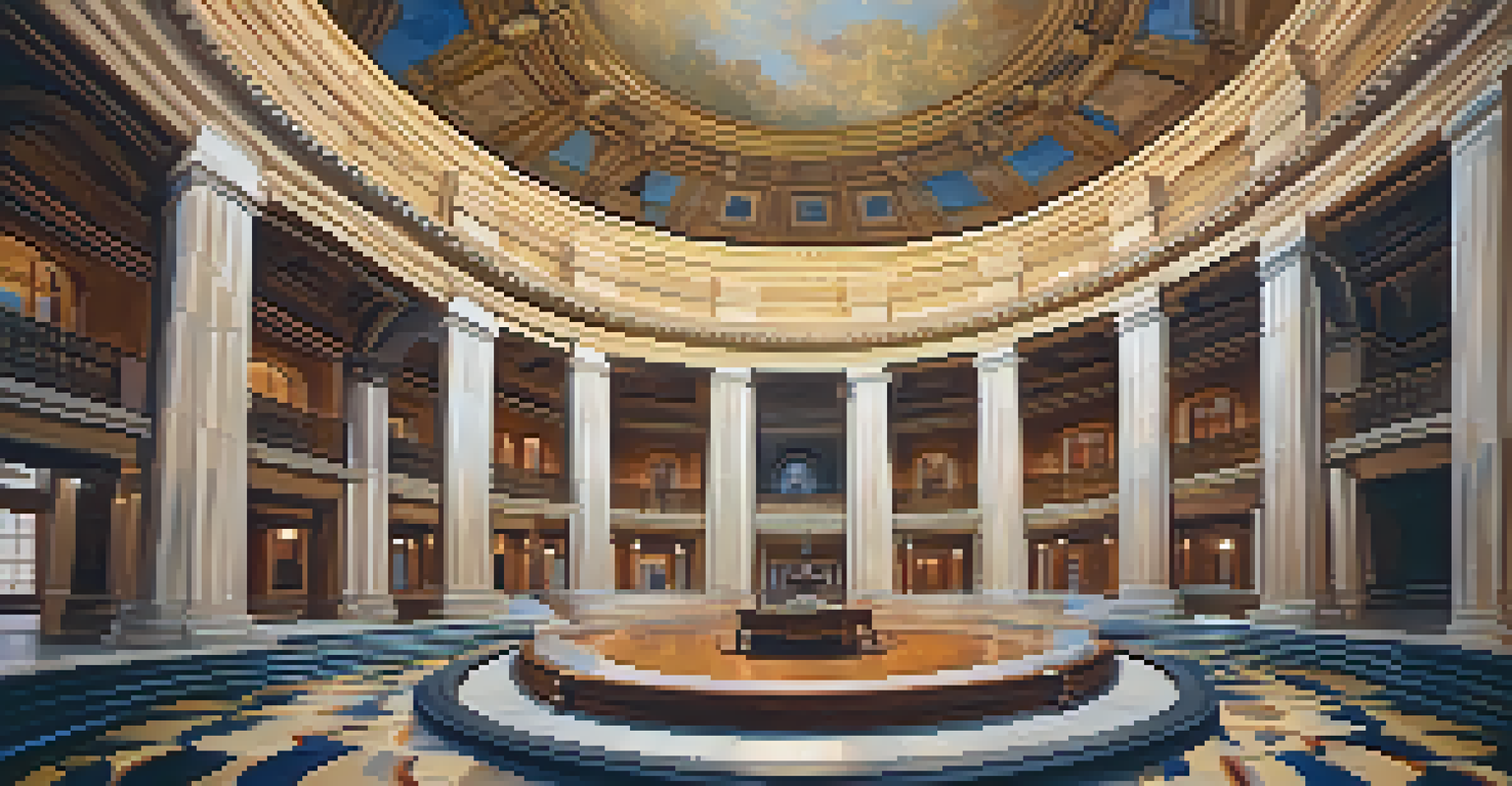Texas State Capitol: A Marvel of Historic Architecture

The Historical Significance of the Texas State Capitol
The Texas State Capitol, completed in 1888, stands as a testament to the state's rich history. It not only serves as the seat of government but also as a symbol of Texas pride. Built after a fire destroyed the previous capitol building, this structure embodies resilience and determination.
Texas is a state of mind, and the Texas State Capitol is its heart.
Designed in the Renaissance Revival style, the Capitol is one of the largest State Capitols in the United States. Its distinctive pink granite, sourced from nearby quarries, gives it a unique charm that sets it apart from others. This building represents more than just politics; it is a monument to the spirit of Texas.
Visitors often marvel at its historical significance, which intertwines with the narrative of Texas itself. As you walk through its halls, you can almost hear echoes of debates and decisions that shaped the state. This connection to history makes the Capitol an essential visit for anyone wanting to understand Texas's past.
Architectural Features That Dazzle the Eye
The architectural design of the Texas State Capitol is nothing short of breathtaking. Its soaring dome reaches a height of 302 feet, making it taller than the U.S. Capitol in Washington, D.C. This impressive feature is not merely for aesthetics; it symbolizes the aspirations and ambitions of Texas.

Intricate details adorn the building, from the ornate carvings to the grand columns that line the entrance. Each element was thoughtfully designed, contributing to a cohesive and majestic appearance. The use of local materials also helps the Capitol blend harmoniously with its surroundings.
Texas Capitol: A Historic Landmark
The Texas State Capitol, completed in 1888, symbolizes the state's resilience and rich history.
One can't help but be captivated by the stunning interiors, which feature beautiful murals and historic artifacts. These elements tell stories of the state's past and the people who have influenced its development. It’s a feast for the eyes and a journey through Texas history all in one visit.
The Role of the Texas State Capitol Today
Today, the Texas State Capitol continues to play a vital role in the state's governance. It houses the offices of the Governor, the Legislature, and various state agencies, making it the hub of political activity. This ongoing function ensures that the Capitol remains a dynamic part of Texan life.
Architecture is a visual art, and the building speaks for itself.
Public access to the building allows citizens to engage with their government, fostering transparency and accountability. Guided tours are available, offering insights into the legislative process and the history of the Capitol. This interaction helps demystify government operations for everyday Texans.
In addition to its political functions, the Capitol hosts numerous events and ceremonies throughout the year. From cultural festivals to commemorations, it serves as a gathering place for the community. This blend of history and modernity keeps the spirit of the Texas State Capitol alive and thriving.
Visiting the Texas State Capitol: A Must-Do Experience
If you're planning a trip to Austin, visiting the Texas State Capitol should be at the top of your list. The building is not only a stunning architectural masterpiece but also a hub of activity and culture. Whether you're a history buff or simply curious, there's something for everyone.
Accessible tours make it easy to explore the Capitol, allowing visitors to learn about its history and architecture. The knowledgeable guides share fascinating stories and answer questions, making the experience engaging and informative. It's an opportunity to connect with Texas's rich heritage.
Architectural Marvel of Texas
Featuring a stunning dome and intricate details, the Capitol is one of the largest and most beautiful state capitols in the U.S.
Surrounding the Capitol, you'll find beautiful gardens and monuments that enhance your visit. These outdoor spaces are perfect for a leisurely stroll or a moment of reflection. The Capitol grounds truly offer a comprehensive experience that showcases the beauty and significance of this historic site.
The Cultural Impact of the Capitol in Texas
The Texas State Capitol is more than just a government building; it's a cultural icon. It has been featured in countless films, documentaries, and literature, highlighting its significance in the broader narrative of Texas. This representation has helped solidify its status as a landmark.
Local artists and musicians often draw inspiration from the Capitol, incorporating its imagery into their work. This creative influence extends to various forms of art, from paintings to performances, showcasing the Capitol's role as a source of inspiration. The building's presence in the arts reflects the deep connection Texans feel to their history.
Moreover, the Capitol regularly hosts cultural events that celebrate Texas's diverse communities. These gatherings foster a sense of unity and pride, reinforcing the Capitol's role as a gathering place for all Texans. It embodies the spirit of the state, where history, culture, and community converge.
Preserving the Legacy of the Texas State Capitol
Preserving the Texas State Capitol is essential for future generations to appreciate its historical and architectural significance. Various restoration projects have been undertaken to maintain its grandeur and ensure its longevity. These efforts reflect a commitment to honoring Texas's past.
Regular maintenance and updates help the Capitol adapt to modern needs while retaining its historical charm. This balance is crucial in preserving the building’s integrity and functionality. The ongoing care of the Capitol demonstrates a dedication to both history and progress.
Cultural Hub for Texans
Beyond its political role, the Capitol serves as a cultural icon, hosting events that foster community and celebrate Texas's diverse heritage.
Community involvement plays a key role in these preservation efforts. Texans are encouraged to participate in initiatives aimed at maintaining the Capitol, fostering a sense of ownership and pride. Together, they ensure that this historic landmark remains a vibrant part of Texas's future.
Fun Facts About the Texas State Capitol
Did you know that the Texas State Capitol is the largest state capitol building in the United States? Its size is a point of pride for many Texans, reflecting the vastness of the state itself. When you stand before it, you can truly appreciate the scale and ambition behind its design.
Another fun fact is that the Capitol's pink granite was sourced locally, making it not only beautiful but also a symbol of Texas's natural resources. The building's distinctive color has become a defining feature and is often associated with the state's identity. It's a perfect example of using local materials to create something remarkable.

Additionally, the Capitol is home to a unique feature: a star on the floor of the rotunda. This star marks the spot where the Capitol's height is measured, adding a playful element to the grandeur of the building. Tourists often enjoy taking pictures with this star, making it a popular photo opportunity.